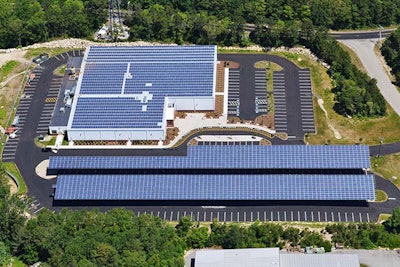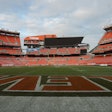
It makes sense that there are more companies dealing in solar power in the state of Hawaii than there are those maintaining recreational ice. In fact, at last count, the breakdown was 300 to one. It makes even more sense, then, that Hawaii’s lone arena, the Ice Palace in Honolulu, is harnessing the power of the sun to optimize its operational efficiency.
Five hundred roof-mounted solar arrays are projected to cut the Ice Palace’s annual energy expenditures by $70,000, or more than $1 million over the life of the project. “Our energy bill has been reduced by about 25 percent, which is a tremendous savings in maintaining an ice rink,” Ice Palace owner Doug Taylor told the Honolulu Star Advertiser in January.
According to John Cheever, renewable energy developer for Distributed Energy Partners, which installed the system last summer, state and federal tax incentives, among other factors, covered more than 90 percent of the undisclosed installation cost. State incentives are particularly attractive in Hawaii, where energy comes mostly from oil and thus costs three times the national average. “It’s pretty much a no-brainer,” Cheever says of the Ice Palace’s solar investment.
Travel about as far east from Hawaii as you can, to Falmouth, Mass., and you’ll discover what likely is the nation’s most extensive array of solar panels serving a single community rink. Before the now-48-year-old Falmouth Youth Hockey League moved into its new home in June 2012, it designed the rink to be larger (50,000 square feet from 30,000), more functional (with an extra half-sheet of ice) and more efficient. Thanks to 3,300 solar panels — which are split between the rink’s roof and a large parking lot carport, and combine to produce roughly 900,000 kilowatt hours per year — the rink is operating at close to net-zero energy consumption.
The power still comes with a price. Through a 20-year contract with Con Edison, which owns the $4.5 million system, the Falmouth rink purchases the power at roughly half the going rate. “We save close to 50 percent on our bills because our purchase power agreement is about half of what it would cost us if we bought it on the open market,” says Falmouth Youth Hockey board member Tom Peterson. “So if the open market is 16 cents a kilowatt hour, we’re buying it at 7.7 cents, which is huge savings with zero investment. It’s a life-saver for us.”
 Becker Arena Products
Becker Arena Products
Falmouth used to close its old rink for several weeks each spring, but the new one remains open year-round, banking solar power gathered during the boom production months of June, July and August for the darker, weather-susceptible dead of winter (January and February). An ice storm, for example, can shut the panels’ production down for a week or more — as was the case this year, according to Peterson.
There are other Massachusetts rinks with smaller solar arrays, but the concept of making ice with help from the sun is not yet widespread — even in New England, with its rich hockey and figure skating heritage. “Part of the problem with solar arrays is retrofitting an old building to have the structural integrity to withstand the excess load on your roof,” Peterson says. “You can’t just throw it on a roof, especially on older buildings, without really doing your homework and making sure it’s structurally sound to withstand the loads. Our building, from the very beginning, was designed for a solar array.”
But structural soundness is only one of two “sticking factors,” as Peterson calls them. “It’s very expensive,” he says. “You’re talking $4.5 million in initial outlay to produce 900,000 kilowatt hours, and that makes it prohibitive for most rinks, because we operate on such tight margins. You really need a partner like we have.”
Fifteen miles up state Highway 28, Gallo Arena in Bourne has found a different kind of partner. Later this year, Gallo, which opened in 1974, will begin tapping into a new solar farm located a half-mile from the arena. “When you’re what they call ‘behind the meter,’ like Tom, you can basically run your building for free, if you have enough solar array,” says John Hickey, Gallo’s rink facility supervisor, adding that the purchase power agreement was signed last November. “If you’re ‘in front of the meter,’ which is what we’re doing, you’re buying it from a solar farm off site and purchasing the electricity for a favorable, agreed-upon rate.”
Hickey adds that Gallo will also be billed for transmission of the electricity by EverSource Energy, which owns the power lines and poles that already exist between the farm and the rink. Even so, Hickey hopes to save around 20 percent on the rink’s annual electricity expenses, which to date have been known to top $150,000 in any given year. “Twenty percent of that would be a significant savings,” he says.
Peterson and Hickey both looked into wind turbines as a potential power source, but determined solar to be the best option. “I think it’s a great idea for everyone to do,” Hickey says. “A solar application is not like a wind turbine, where something is sticking up in the air and moving around. It’s a little more appealing for the general public, because it’s not something that’s an eyesore from afar.”
In Hawaii, where warm temperatures and high humidity present an ice-making challenge to begin with, the Ice Palace’s exploitation of solar power is being curtailed by what Peterson might describe as a third sticking factor. Local utility Hawaiian Electric actually limits the amount of solar power the Ice Palace can produce, according to Cheever. When asked why that is, he says, “Anytime there’s no demand onsite, that power is being pumped onto the electric grid, and so the main argument is safety. They say, ‘The grid is designed to send power in one direction, and photovoltaic systems are sending power in the opposite direction.’ And so the argument is that they can’t have too much PV power put onto their grid because they can’t completely control it or even know exactly how much is coming at any particular time.”
It’s an argument that’s slowly being debunked, Cheever says. “You see the pictures and think, ‘They have so much roof space, and they’re only covering 25 percent of their bill, why don’t they put up more?’ The reason that we didn’t is because of the utility.”
Meanwhile, Peterson predicts a bright future for solar power in the recreational ice industry. In fact, he doesn’t think a rink should be constructed without at least considering photovoltaic panels. “Every year they’re getting more efficient — and smaller,” he says. “The technology just keeps getting better and better. I’m surprised they’re not utilized more. I would definitely look into it.”
RELATED:





































